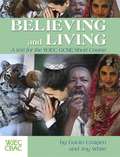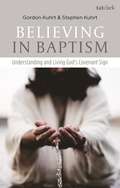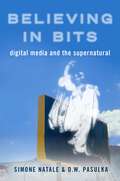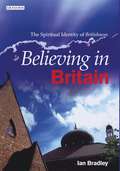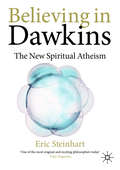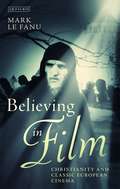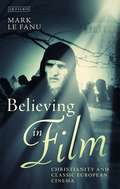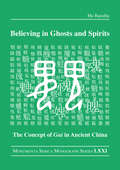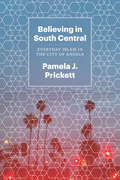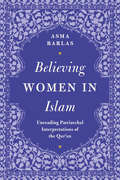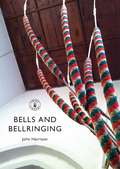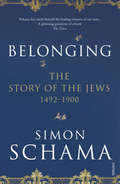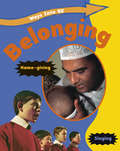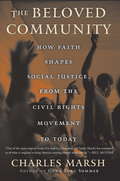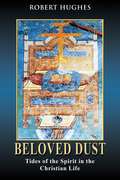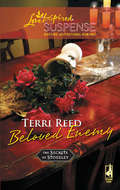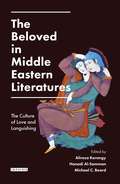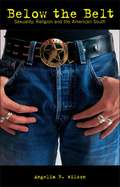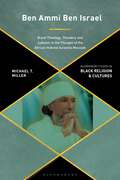- Table View
- List View
Believing and Living: a text for the WJEC GCSE short course (PDF)
by Craigen Gavin Joy WhiteFocusing on the five units of the WJEC short course, Believing and Living examines Christianity, Judaism, Islam and Hinduism as well as addressing general human experience. The book includes key skills activities and examination practice questions.
Believing and Living: a text for the WJEC GCSE short course (PDF)
by Craigen Gavin Joy WhiteFocusing on the five units of the WJEC short course, Believing and Living examines Christianity, Judaism, Islam and Hinduism as well as addressing general human experience. The book includes key skills activities and examination practice questions.
Believing and Living: a text for the WJEC GCSE short course
by Craigen Gavin Joy WhiteFocusing on the five units of the WJEC short course, Believing and Living examines Christianity, Judaism, Islam and Hinduism as well as addressing general human experience. The book includes key skills activities and examination practice questions.
Believing in Baptism: Understanding and Living God's Covenant Sign
by Stephen Kuhrt Gordon KuhrtIncluding a Foreword by the Rt. Rev. Graham Tomlin, this volume examines the theology and practice of baptism. It contains a narrative introduction that highlights the different approaches taken to baptism, and the various issues that come with them. The volume also covers how the changing cultural context within Britain has influenced responses to baptism. At the heart of the book is a detailed examination of the theme of covenant running through the Bible and how this shapes its understanding of baptism.Gordon Kuhrt and his son Stephen explore several controversial issues associated with baptism. Believing in Baptism contains an in-depth discussion of the sacramental issues surrounding baptismal 'efficacy', for instance, as well as infant or family baptism. The authors also examine the 'Baptist' view, discrimination in Baptism and the issue of 'Rebaptism'. Finally, they consider the issue of 'Baptism and its Completion?', and make practical recommendations on the ways in which baptism should be taught and lived in the local church.
Believing in Baptism: Understanding and Living God's Covenant Sign
by Stephen Kuhrt Gordon KuhrtIncluding a Foreword by the Rt. Rev. Graham Tomlin, this volume examines the theology and practice of baptism. It contains a narrative introduction that highlights the different approaches taken to baptism, and the various issues that come with them. The volume also covers how the changing cultural context within Britain has influenced responses to baptism. At the heart of the book is a detailed examination of the theme of covenant running through the Bible and how this shapes its understanding of baptism.Gordon Kuhrt and his son Stephen explore several controversial issues associated with baptism. Believing in Baptism contains an in-depth discussion of the sacramental issues surrounding baptismal 'efficacy', for instance, as well as infant or family baptism. The authors also examine the 'Baptist' view, discrimination in Baptism and the issue of 'Rebaptism'. Finally, they consider the issue of 'Baptism and its Completion?', and make practical recommendations on the ways in which baptism should be taught and lived in the local church.
Believing in Bits: Digital Media and the Supernatural
Believing in Bits advances the idea that religious beliefs and practices have become inextricably linked to the functioning of digital media. How did we come to associate things such as mindreading and spirit communications with the functioning of digital technologies? How does the internetâs capacity to facilitate the proliferation of beliefs blur the boundaries between what is considered fiction and fact? Addressing these and similar questions, the volume challenges and redefines established understandings of digital media and culture by employing the notions of belief, religion, and the supernatural.
BELIEVING IN BITS C: Digital Media and the Supernatural
by Simone Natale, D. W. PasulkaBelieving in Bits advances the idea that religious beliefs and practices have become inextricably linked to the functioning of digital media. How did we come to associate things such as mindreading and spirit communications with the functioning of digital technologies? How does the internetâs capacity to facilitate the proliferation of beliefs blur the boundaries between what is considered fiction and fact? Addressing these and similar questions, the volume challenges and redefines established understandings of digital media and culture by employing the notions of belief, religion, and the supernatural.
Believing in Britain: The Spiritual Identity of 'Britishness'
by Ian BradleyWhy is there such intense interest today in the idea of 'Britishness'? Does it really matter, and what is 'Britishness' anyway? Why does the notion of 'being British' seem to have most resonance amongst recent immigrant - especially Asian and Afro-Caribbean - communities? And why is that 'traditional' British values now seem to be most widely practised and cherished by newcomers, not by the dominant majority?This book answers these vital questions by making a unique contribution to the current debate about British identity. It investigates why Liverpool is the most British of UK cities, with a regional accent representing a medley of Welsh, Scots, Irish and English; how a small village off the M6 motorway is arguably Britain's spiritual heart; and what theme parks, airport shops and eating habits have to tell us about the contemporary national character. It is often claimed that Great Britain is one of the most secular nations on earth. But – controversially – Ian Bradley argues that Britishness is best envisaged as a series of overlapping identities which are at root religious. He views the 400 year-old Union Jack, with its overlaid crosses of three of the nation's four patron saints, as symbolising the United Kingdom's unparalleled combination of unity in diversity, the diversity of a society which now embodies Muslim, Jewish, Hindu, Buddhist and many other – including secular – traditions. He goes on to argue that 'Britishness' has special value as a broad church measure of spiritual and cultural inclusiveness – and as a positive alternative to fundamentalism, narrow nationalism and jingoism. The author explores in separate chapters the distinctive contributions to Britishness made over the centuries by the Celtic traditions of the Welsh and Irish, the Anglo-Saxon strain of tolerance and freedom associated with the English, the moral seriousness of the Scots, and the characteristics of exuberance, modesty and privacy introduced by new black and Asian Britons. Published to coincide with the three hundredth anniversary of the 1707 Act of Union, his book offers a number of radical proposals. These include re-designing the Union flag to incorporate a black cross on a gold background, to better reflect the hybridity of contemporary Britain, and replacing George, Andrew and Patrick with a new trinity of patron saints – Columba, Bridget and Edward the Confessor. Ian Bradley contends that a rejuvenated BBC, monarchy and Commonwealth all have a part to play in forging a new sense of British identity which combines myth, imagination and tradition with a broad, open-minded inclusivity and respect for difference. Believing in Britain makes a consistently thoughtful and challenging contribution to one of the most important discussions of our time.
Believing in Dawkins: The New Spiritual Atheism
by Eric SteinhartDawkin's militant atheism is well known; his profound faith less well known In this book, atheist philosopher Eric Steinhart explores the spiritual dimensions of Richard Dawkins’ books, which are shown to encompass:· the meaning and purpose of life· an appreciation of Platonic beauty and truth· a deep belief in the rationality of the universe· an aversion to both scientism and nihilism As an atheist, Dawkins strives to develop a scientific alternative to theism, and while he declares that science is not a religion, he also proclaims it to be a spiritual enterprise. His books are filled with fragmentary sketches of this ‘spiritual atheism’, resembling a great unfinished cathedral. This book systematises and completes Dawkins’ arguments and reveals their deep roots in Stoicism and Platonism. Expanding on Dawkins’ ideas, Steinhart shows how atheists can develop powerful ethical principles, compelling systems of symbols and images, and meaningful personal and social practices. Believing in Dawkins is a rigorous and potent entreaty for the use of science and reason to support spiritually rich and optimistic ways of thinking and living.
Believing in Film: Christianity and Classic European Cinema (Cinema and Society)
by Mark Le FanuWe live in a secular world and cinema is part of that secular edifice. There is no expectation, in modern times, that filmmakers should be believers – any more than we would expect that to be the case of novelists, poets and painters. Yet for all that this is true, many of the greatest directors of classic European cinema (the period from the end of World War II to roughly the middle of the 1980s) were passionately interested not only in the spiritual life but in the complexities of religion itself. In his new book Mark Le Fanu examines religion, and specifically Christianity, not as the repository of theological dogma but rather as an energizing cultural force – an 'inflexion' – that has shaped the narrative of many of the most striking films of the twentieth century. Discussing the work of such cineastes as Eisenstein and Tarkovsky from Russia; Wajda, Zanussi and Kieslowski from Poland; France's Rohmer and Bresson; Pasolini, Fellini and Rossellini from Italy; the Spanish masterpieces of Buñuel, and Bergman and Dreyer from Scandinavia, this book makes a singular contribution to both film and religious studies.
Believing in Film: Christianity and Classic European Cinema (Cinema and Society)
by Mark Le FanuWe live in a secular world and cinema is part of that secular edifice. There is no expectation, in modern times, that filmmakers should be believers – any more than we would expect that to be the case of novelists, poets and painters. Yet for all that this is true, many of the greatest directors of classic European cinema (the period from the end of World War II to roughly the middle of the 1980s) were passionately interested not only in the spiritual life but in the complexities of religion itself. In his new book Mark Le Fanu examines religion, and specifically Christianity, not as the repository of theological dogma but rather as an energizing cultural force – an 'inflexion' – that has shaped the narrative of many of the most striking films of the twentieth century. Discussing the work of such cineastes as Eisenstein and Tarkovsky from Russia; Wajda, Zanussi and Kieslowski from Poland; France's Rohmer and Bresson; Pasolini, Fellini and Rossellini from Italy; the Spanish masterpieces of Buñuel, and Bergman and Dreyer from Scandinavia, this book makes a singular contribution to both film and religious studies.
Believing in Ghosts and Spirits: The Concept of Gui in Ancient China (Monumenta Serica Monograph Series)
by Hu BaozhuThe present book by Hu Baozhu explores the subject of ghosts and spirits and attempts to map the religious landscape of ancient China. The main focus of attention is the character gui 鬼, an essential key to the understanding of spiritual beings. The author analyses the character gui in various materials – lexicons and dictionaries, excavated manuscripts and inscriptions, and received classical texts. Gui is examined from the perspective of its linguistic root, literary interpretation, ritual practices, sociopolitical implication, and cosmological thinking. In the gradual process of coming to know the otherworld in terms of ghosts and spirits, Chinese people in ancient times attempted to identify and classify these spiritual entities. In their philosophical thinking, they connected the subject of gui with the movement of the universe. Thus the belief in ghosts and spirits in ancient China appeared to be a moral standard for all, not only providing a room for individual religiosity but also implementing the purpose of family-oriented social order, the legitimization of political operations, and the understanding of the way of Heaven and Earth.
Believing in Ghosts and Spirits: The Concept of Gui in Ancient China (Monumenta Serica Monograph Series)
by Hu BaozhuThe present book by Hu Baozhu explores the subject of ghosts and spirits and attempts to map the religious landscape of ancient China. The main focus of attention is the character gui 鬼, an essential key to the understanding of spiritual beings. The author analyses the character gui in various materials – lexicons and dictionaries, excavated manuscripts and inscriptions, and received classical texts. Gui is examined from the perspective of its linguistic root, literary interpretation, ritual practices, sociopolitical implication, and cosmological thinking. In the gradual process of coming to know the otherworld in terms of ghosts and spirits, Chinese people in ancient times attempted to identify and classify these spiritual entities. In their philosophical thinking, they connected the subject of gui with the movement of the universe. Thus the belief in ghosts and spirits in ancient China appeared to be a moral standard for all, not only providing a room for individual religiosity but also implementing the purpose of family-oriented social order, the legitimization of political operations, and the understanding of the way of Heaven and Earth.
Believing in South Central: Everyday Islam in the City of Angels
by Pamela J. PrickettThe area of Los Angeles known as South Central is often overshadowed by dismal stereotypes, problematic racial stigmas, and its status as the home to some of the city’s poorest and most violent neighborhoods. Amid South Central’s shifting demographics and its struggles with poverty, sociologist Pamela J. Prickett takes a closer look, focusing on the members of an African American Muslim community and exploring how they help each other combat poverty, job scarcity, violence, and racial injustice. Prickett’s engaging ethnography relates how believers in this longstanding religious community see Islam as a way of life, a comprehensive blueprint for individual and collective action, guiding how to interact with others, conduct business, strive for progress, and cultivate faith. Prickett offers deep insights into the day-to-day lived religion of the Muslims who call this community home, showing how the mosque provides a system of social support and how believers deepen their spiritual practice not in spite of, but through, conditions of poverty. Prickett breaks past the stigmas of urban poverty, revealing a complex and vibrant community by telling the stories of longstanding residents of South Central—like Sister Ava, who offers food to the local unhoused people and finds the sacred in her extensive DVD collection. In addition to her portraits of everyday life among Muslims in South Central, Prickett also provides vivid and accessible descriptions of Ramadan and histories of the mosque, situates this community within the larger story of the Nation of Islam, explores gender issues, and unpacks the interaction between African American Muslims and South Asian and Arab American Muslims, revealing both the global and local significance of this religious tradition.
Believing in South Central: Everyday Islam in the City of Angels
by Pamela J. PrickettThe area of Los Angeles known as South Central is often overshadowed by dismal stereotypes, problematic racial stigmas, and its status as the home to some of the city’s poorest and most violent neighborhoods. Amid South Central’s shifting demographics and its struggles with poverty, sociologist Pamela J. Prickett takes a closer look, focusing on the members of an African American Muslim community and exploring how they help each other combat poverty, job scarcity, violence, and racial injustice. Prickett’s engaging ethnography relates how believers in this longstanding religious community see Islam as a way of life, a comprehensive blueprint for individual and collective action, guiding how to interact with others, conduct business, strive for progress, and cultivate faith. Prickett offers deep insights into the day-to-day lived religion of the Muslims who call this community home, showing how the mosque provides a system of social support and how believers deepen their spiritual practice not in spite of, but through, conditions of poverty. Prickett breaks past the stigmas of urban poverty, revealing a complex and vibrant community by telling the stories of longstanding residents of South Central—like Sister Ava, who offers food to the local unhoused people and finds the sacred in her extensive DVD collection. In addition to her portraits of everyday life among Muslims in South Central, Prickett also provides vivid and accessible descriptions of Ramadan and histories of the mosque, situates this community within the larger story of the Nation of Islam, explores gender issues, and unpacks the interaction between African American Muslims and South Asian and Arab American Muslims, revealing both the global and local significance of this religious tradition.
Believing Women' in Islam: Unreading Patriarchal Interpretations of the Qur'an
by Asma BarlasDoes Islam call for the oppression of women? The subjugation of women in many Muslim countries is often used as evidence of this, while many Muslims read the Qur’an in ways that seem to justify sexual oppression and inequality. In this paradigm-shifting book, Asma Barlas argues that, far from supporting male privilege, the Qur’an actually affirms the complete equality of the sexes.Offering a historical analysis of religious authority and knowledge, Barlas shows how, for centuries, Muslims have read patriarchy into the Qur’an to justify existing religious and social structures. In this seminal volume, she takes readers into the heart of Islamic teachings on women, gender and patriarchy, offering an egalitarian reading of Islam’s most sacred scripture.This revised edition includes two new chapters, a new preface, and updates throughout.
Bells and Bellringing (Shire Library)
by John HarrisonHandel called Britain 'The Ringing Isle' because he heard bells ringing everywhere he went. Behind the quintessentially English sound of bells ringing lies a unique way of hanging bells and a special way of ringing them that evolved in the late sixteenth century. Ringing has since developed and spread, with some 6,000 towers worldwide with bells hung in the English style, and most of them in England. Over 40,000 active ringers keep alive the traditions and skills of change ringing that have been handed down over many generations.The book is an introduction to the world of bells and bell-ringing. It explains how bells are made and how a ringing installation works. It explains the nature of change ringing, which has mathematical as well as musical aspects. It provides insights into the ringing community its origins and culture as well as its relationships with the Church and the community.
Belonging: The Story of the Jews 1492–1900
by Simon Schama CbeSHORTLISTED FOR THE BAILLIE GIFFORD PRIZESelected as a Book of the Year 2017 by the Daily Telegraph, Mail on Sunday and Observer 'A glittering gemstone of a book' The TimesThe Jewish story is a history that is about, and for, all of us. And in our own time of anxious arrivals and enforced departures, the Jews’ search for a home is more startlingly resonant than ever. Belonging is a magnificent cultural history abundantly alive with energy, character and colour. It spans centuries and continents, from the Jews’ expulsion from Spain in 1492 it navigates miracles and massacres, wandering, discrimination, harmony and tolerance; to the brink of the twentieth century and, it seems, a point of profound hope.It tells the stories not just of rabbis and philosophers but of a poetess in the ghetto of Venice; a boxer in Georgian England; a general in Ming China; an opera composer in nineteenth-century Germany. The story unfolds in Kerala and Mantua, the starlit hills of Galilee, the rivers of Colombia, the kitchens of Istanbul, the taverns of Ukraine and the mining camps of California. It sails in caravels, rides the stage coaches and the railways; trudges the dawn streets of London, hobbles along with the remnant of Napoleon’s ruined army. Through Schama’s passionate telling of this second chronicle in an epic tale, a history emerges of the Jewish people that feels it is the story of everyone, of humanity.
Belonging: Belonging (Ways Into RE)
by Louise SpilsburyA friendly and very visual introduction to the key principles and practices of the world`s six main religious faiths.
The Beloved Community: How Faith Shapes Social Justice from the Civil Rights Movement to Today
by Charles MarshA noted theologian explains how the radical idea of Christian love animated the African American civil rights movement and how it can power today's social justice strugglesSpeaking to his supporters at the end of the Montgomery bus boycott in 1956, Martin Luther King, Jr., declared that their common goal was not simply the end of segregation as an institution. Rather, "the end is reconciliation, the end is redemption, the end is the creation of the beloved community." King's words reflect the strong religious convictions that motivated the African American civil rights movement. As King and his allies saw it, "Jesus had founded the most revolutionary movement in human history: a movement built on the unconditional love of God for the world and the mandate to live in that love." Through a commitment to this idea of love and to the practice of nonviolence, civil rights leaders sought to transform the social and political realities of twentieth-century America. In The Beloved Community, theologian and award-winning author Charles Marsh traces the history of the spiritual vision that animated the civil rights movement and shows how it remains a vital source of moral energy today. The Beloved Community lays out an exuberant new vision for progressive Christianity and reclaims the centrality of faith in the quest for social justice and authentic community.
Beloved Dust: Tides of the Spirit in the Christian Life
by Robert Davis Hughes IIIThere has been an explosion of interest in classical Christian spirituality over the past 50 years. While a great deal of work has been done on the history of Christian spirituality, there has been no full-scale theological and pastoral treatment of Christian spiritual life since before the Second Vatican Council.Beloved Dust takes a realistic, contemporary view of human being as entirely physical (dust) and shows it immersed in three great tides of the Holy Spirit, the traditional threefold rhythm of conversion, transfiguration, and glory. What is unique about Robert Hughes's approach is the effort to root spiritual theology in the doctrine of the Spirit, an outgrowth of the renewed interest in the Trinity among both Catholics (Karl Rahner) and Protestants (Robert Jenson). Also striking is Hughes's emphasis on "ordinary life". Here as a married Episcopal priest/theologian who brings a distinctly "Protestant" perspective to a traditionally "Catholic" enterprise for so long the preserve of celibate priests. What he achieves is a new presentation of the traditional teaching in the light of contemporary knowledge and practice.
Beloved Enemy (The Secrets of Stoneley #4)
by Terri ReedFROM THE DESK OF JULIET BLANCHARD I thought working in our family firm would finally make my father show some interest in me. He's always been distant toward me–possibly because I might not be his child? (I found an incriminating photo of my long-presumed-dead mother with a man I resemble.)
The Beloved in Middle Eastern Literatures: The Culture of Love and Languishing (Library of Middle East History)
by Alireza Korangy Hanadi Al-Samman Michael BeardIn the long literary history of the Middle East, the notion of 'the beloved' has been a central trope in both the poetry and prose of the region. This book explores the concept of the beloved in a cross-cultural and interdisciplinary manner, revealing how shared ideas on the subject supersede geographical and temporal boundaries, and ideas of nationhood. The book considers the beloved in its classical, modern and postmodern manifestations, taking into account the different sexual orientations and forms of desire expressed. From the pre-Islamic 'Udhri (romantic unrequited love), to the erotic same-sex love in thirteenth century poetry and prose, the divine Sufi reflections on the topic, and post-revolutionary love encounters in Iran, Egypt and Saudi Arabia, The Beloved in Middle Eastern Literatures connects the affective and cultural with the political and the obscene. In focusing on the diverse manifestations of love and tropes of the lover/beloved binary, this book is unique in foregrounding what is often regarded as a 'taboo subject' in the region. The multi-faceted outlook reveals the variety of philological, philosophical, poetic and literary forms that treat this significant motif.
Below the Belt: Religion, Sexuality and Politics in the Rural South
by Angelia WilsonAlternative lifestyles are anathema to the inhabitants of rural areas of the Bible Belt. Even gays and lesbians themselves resist the notions of community and self-identification espoused by city queers. As Wilson demonstrates, it is the combination of internalized self-hatred, the influence of the right-wing Republicans and religious fervor, together with the hatred, fear, and suspicion aroused by the intervention of gay and lesbian activists from urban areas, that determine the tenor of gay life in the American rural South. A series of shocking interviews with local religious leaders and medical experts whose opinions shape local discourse in sexuality, abortion, feminiosm, and AIDS are the foundation for this revelatory study.
Ben Ammi Ben Israel: Black Theology, Theodicy and Judaism in the Thought of the African Hebrew Israelite Messiah (Bloomsbury Studies in Black Religion and Cultures)
by Michael MillerThis text introduces Ben Ammi, the leader and theologian of the African Hebrew Israelite community, as a systematic thinker and theologian. It examines his many books and speeches in order to provide a comprehensive introduction to his thought in the context of both African American and Jewish contemporaries and precursors.Divided into three thematic sections, History, Law, and Language, the text introduces Ben Ammi's understanding of the nature of God, the responsibilities of the human, and the narrative of history. Ben Ammi was a deeply spiritual but also remarkably modern thinker who blended scientific thought into his evolving socio-theology, while seeking to remove religion from the realm of mythology. The book evaluates how Ben Ammi's theology is one bound to concepts of humility and learning how to go with the grain of the natural world in order to find humanity's true center as a part of nature.
